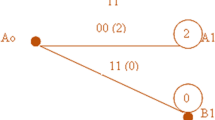Abstract
Cooperative diversity using distributed space-time codes has been recently proposed to form virtual antennas in order to achieve diversity gain. In this paper, we consider a multi-relay network operating in amplify-and-forward (AAF) mode. Motivated by protocol III presented in (Nabar et al. 2004), we propose a cooperative diversity protocol implementing space–time coding for an arbitrary number of relay nodes when the source-destination link contributes in the second phase. We consider the use of real-orthogonal and quasi-orthogonal designs of space–time codes as they give better performance than random linear-dispersion codes. The pairwise error probability (PEP) has been derived and the theoretical analysis demonstrates that the proposed protocol achieves a diversity of order N + 1, where N is the number of relay nodes. No instantaneous channel state information is required at the relay nodes. The optimum power allocation that minimizes the PEP is obtained with numerical and theoretical analysis. The aggregate system power constraint is considered in the optimization. Simulation results demonstrate an improvement over the existing orthogonal protocols for different source-destination channel conditions. The results also show that the proposed scheme is robust to the channel estimation errors







Similar content being viewed by others
References
Foschini, G. J. (1996). Layered space-time architecture for wireless communication in a fading environment when using multi-element antennas. Bell Labs Technical Journal, 1(2), 41–59.
Tarokh, V., Seshadri, N., & Calderbank, A. R. (1998). Space-time codes for high data rate wireless communication: performance criterion and code construction. IEEE Transactions on Information Theory, 44(2), 744–765.
Nabar, R., Bolkskei, H., & Kneubuhler, W. (2004). Fading relay channels: performance limits and space-time signal design. IEEE Journal on Selected Areas in Communication, 22(6).
Sendonaris, A., Erkip, E., & Aazhang, B. (2003). User cooperation diversity-part I: system description. IEEE Transactions on Communications, 51(11), 1927–1938.
Sendonaris, A., Erkip, E., & Aazhang, B. (2003). User cooperation diversity-Part II: Implementation aspects and performance analysis. IEEE Transactions on Communications, 51(11), 1927–1938.
Laneman, J., Tse, D., & Wornell, G. W. (2004). Cooperative diversity in wireless networks: efficient protocols and outage behavior. IEEE Transactions on Information Theory, 50(12), Dec.
Laneman, J., & Wornell, G. W. (2004). Distributed space–time coded protocols for exploiting cooperative diversity in wireless networks. IEEE Transactions on Information Theory, 50(12), Dec.
Jing, Y., & Hassibi, B. (2006). Distributed space–time coding in wireless relay networks. IEEE Transaction on Wireless Communications, 5(12). Dec.
Seddik, K. G., Sadek, A. K., Ibrahim, A. S., & Ray Liu, K. J. (2008). Design criteria and performance analysis for distributed space-time coding. IEEE Transactions on Vehicular Technology, 57(4), 2446–2451.
Jing, Y., & Jafarkhani, H. (2007). Using orthogonal and quasi-orthogonal designs in wireless relay networks. IEEE Transactions on Information Theory, 53(11), 4106–4118.
Maham, B., & Hjorunbnes, A. (2007). Distributed GABBA space–time-codes in amplify-and-forward cooperation. In proc. IEEE Information Theory Workshop (ITW), Bergen, Norway, pp 189–193, July.
Jing, Y., & Hassibi, B. (2008). Diversity analysis of distributed space–time codes in relay networks with multiple transmit/receive antennas. EURASIP Journal on Advances in Signal Processing.
Zhang, W., & Lataief, K. B. (2008). Full-arte distributed space-time codes for cooperative communications. IEEE Transaction on Wireless Communications, 7(7), 2446–2451.
Zhang, W., Li, Y., Xia, X. G., & Lataief, K. B. (2008). Distributed space-frequency coding for cooperative diversity in broadband wireless ad hoc networks. IEEE Transaction on Wireless Communications, 7(3), 955–1003.
Jafarkhani, H. (2005). Space–time coding: Theory and practice. Cambridge University Press.
Goldsmith, A. (2005). Wireless communications. Cambridge University Press.
Horn, R. A., & Johnson, C. R. (1985). Matrix analysis. Cambridge: Cambridge Univ. Press.
Author information
Authors and Affiliations
Corresponding author
Rights and permissions
About this article
Cite this article
Al-nahari, A.Y., Dessouky, M.I. & Abd El-Samie, F.E. Cooperative Space–Time Coding with Amplify-and- Forward Relaying. J Sign Process Syst 67, 129–138 (2012). https://doi.org/10.1007/s11265-010-0516-3
Received:
Revised:
Accepted:
Published:
Issue Date:
DOI: https://doi.org/10.1007/s11265-010-0516-3




